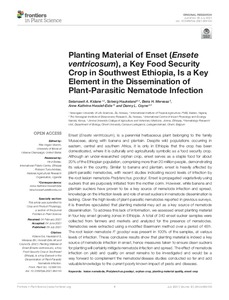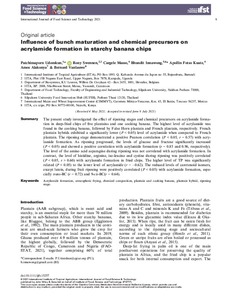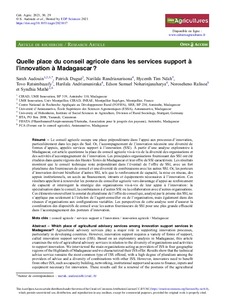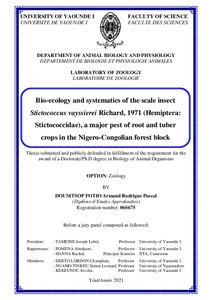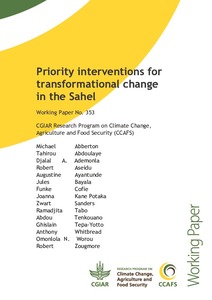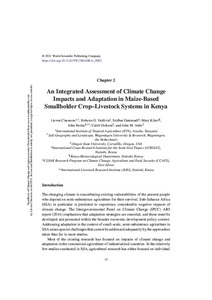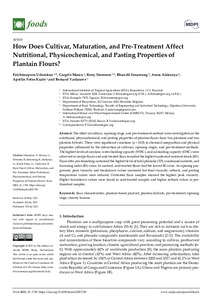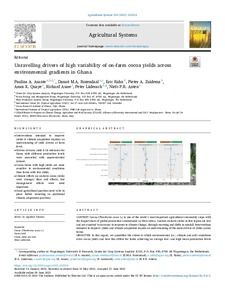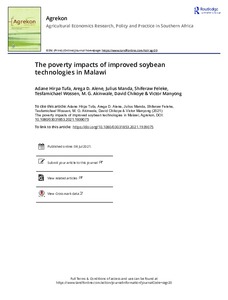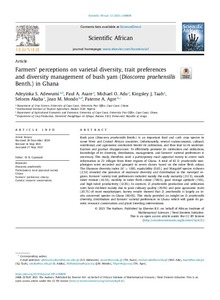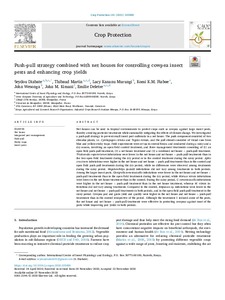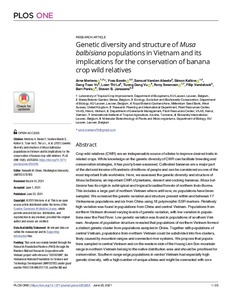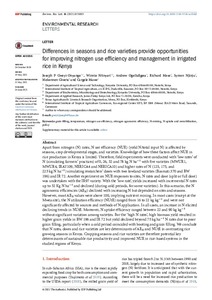Welcome to the International Institute of Tropical Agriculture Research Repository
IITA Bibliography System: Recent submissions
Now showing items 1281-1300 of 7933
-
Planting material of enset (Ensete ventricosum), a key food security crop in southwest Ethiopia, is a key element in the dissemination of plant-parasitic nematode infection
(2021)Enset (Ensete ventricosum), is a perennial herbaceous plant belonging to the family Musaceae, along with banana and plantain. Despite wild populations occurring in eastern, central and southern Africa, it is only in Ethiopia that the crop has been domesticated, where it is culturally and agriculturally symbolic as a food security crop. Although an under-researched orphan crop, enset serves as a staple food for about 20% of the Ethiopian population, comprising more than 20 million people, demonstrating ... -
Genetic diversity and heterotic orientation of South Africa maize inbred lines towards tropical and temperate testers
(2021)An ecient hybrid breeding program denes and utilizes few heterotic groups. The objectives of this study were to determine genetic diversity and alignment of South Africa maize inbred lines collection towards tropical and temperate testers. Forty-two maize inbred lines were genotyped with 56110 single nucleotide polymorphism (SNP) DNA markers, using the Illumina MaizeSNP50 Bead chip. The 42 lines were crossed to two tropical and two temperate inbred line testers. The testcrosses were evaluated ... -
Influence of bunch maturation and chemical precursors on acrylamide formation in starchy banana chips
(2021-07-13)The present study investigated the effect of ripening stages and chemical precursors on acrylamide formation in deep-fried chips of five plantains and one cooking banana. The highest level of acrylamide was found in the cooking banana, followed by False Horn plantain and French plantain, respectively. French plantain hybrids exhibited a significantly lower (P < 0.05) level of acrylamide when compared to French plantain. The ripening stage demonstrated a positive Pearson correlation (P < 0.05, r = ... -
Quelle place du conseil agricole dans les services support a l'innovation a Madagascar?
(2021)Le conseil agricole occupe une place prépondérante dans l’appui aux processus d’innovation, particulièrement dans les pays du Sud. Or, l’accompagnement de l’innovation nécessite une diversité de formes d’appuis, appelés services support à l’innovation (SSI). À partir d’une analyse exploratoire à Madagascar, cet article questionne la place du conseil agricole vis-à-vis de la diversité des organisations et des activités d’accompagnement de l’innovation. Les principales organisations fournissant des ... -
Assessing performance of white endosperm testers with varying resistance reactions to Striga (Striga hermonthica) for evaluating resistant maize (Zea mays) inbred lines
(2021-07-15)Identification of testers is crucial for hybrid maize breeding programme. However, limited information is available about ideal testers for characterising the combining ability of Striga resistant maize inbreds. This study was conducted to assess the relative value of three inbred testers with varying resistance reactions to Striga for determining the combining ability of Striga resistant inbreds. Ninety testcrosses involving 30 Striga resistant inbreds and three testers were evaluated under ... -
Are risk preferences consistent across elicitation procedures? A field experiment in Congo basin countries
(2021)We compare individual risk preferences elicited through a classic Ordered Lottery Selection (OLS) procedure with five gambles, and an extended procedure composed of nine gambles. The research question is about the consistency of the risk preferences across these two elicitation variants. We implemented a field experiment with 1002 rural households in the Congo Basin from December 2013 to July 2014. We show that 1/3 of the sample is extremely risk averse regardless of the procedure. We found ... -
Bio-ecology and systematics of the scale insect Stictococcus vayssierei Richard, 1971 (Hemiptera: Stictococcidae), a major pest of root and tuber crops in the Nigero-Congolian forest block
(2021)Stictococcus vayssierei Richard, 1971 commonly known as the African root and tuber scale (ARTS), was first identified as an agricultural pest in the early 1980s. Following population outbreaks in Cameroon and the Democratic Republic of Congo in late 1980s – early 1990s, the insect is currently reported as one of the major pests threatening root and tuber crop production in Central Africa. Outbreaks can merely be viewed as symptomatic of some breakdown of internal organization and extrinsic factors ... -
Priority interventions for transformational change in the Sahel
(Wageningen University and Research Center, 2021)The Sahel region holds both challenges and opportunities for smallholder agriculture/agropastoralism. Market opportunities for food producers in the region have improved due to population growth, urbanization, income growth, dietary diversification and higher output prices. However, alongside land degradation and climate change, an increased dependence on dynamic food (and feed) value chains and on volatile markets indicates the need to address structural constraints such as limited access to ... -
Visual soil examination and evaluation in the sub-humid and semi-arid regions of Kenya
(2021-07-10)Soil quality is indicated by the interaction of physical, chemical and biological soil properties. The importance of physical properties, for example soil structure, lies in the fact that they enhance chemical and biological soil functions. Consequently, periodic assessment of structural quality is an important aspect of soil quality management. Quantitative soil properties can be used as indirect indicator parameters for soil structural changes. However, measuring these properties is not applicable, ... -
How does cultivar, maturation, and pre-treatment affect nutritional, physicochemical, and pasting properties of plantain flours?
(2021-07-29)The effect of cultivar, ripening stage, and pre-treatment method were investigated on the nutritional, physicochemical, and pasting properties of plantain flours from two plantains and two plantain hybrids. There were significant variations (p < 0.05) in chemical composition and physical properties influenced by the interaction of cultivars, ripening stages, and pre-treatment methods. The highest levels of amylose, water-holding capacity (WHC), and oil-holding capacity (OHC) were observed in unripe ... -
Ethnobotanical characterization of scarlet eggplant (Solanum aethiopicum L.) varieties cultivated in Benin (West Africa)
(2021-09)The African eggplant (Solanum aethiopicum L.) is an important traditional vegetable cultivated in tropical regions for its edible fruits. In the Benin Republic, S. aethiopicum is mainly cultivated by rural farmers for food and for its use in traditional medicine. Assessing varietal diversity, endogenous knowledge, production constraints and farmers' preference criteria are of great importance for promotion and conservation purposes. Using rural appraisal tools and methods, an ethnobotanical study ... -
Unravelling drivers of high variability of on-farm cocoa yields across environmental gradients in Ghana
(2021-10)CONTEXT Cocoa (Theobroma cacao L.) is one of the world's most important agricultural commodity crops with the largest share of global production concentrated in West Africa. Current on-farm yields in this region are low and are expected to decrease in response to climate change, through warming and shifts in rainfall. Interventions intended to improve yields and climate adaptation require an understanding of the main drivers of yields across farms. OBJECTIVE In this regard, we quantified the extent ... -
The poverty impacts of improved soybean technologies in Malawi
(2021)Improved soybean varieties and agronomic practices have been widely disseminated to smallholder farmers in Malawi over the last 15 years. However, there is no empirical evidence on the welfare impacts of adopting improved soybean technologies. This paper estimated the poverty impacts of adopting improved soybean technologies using data from 1,234 households in six soybean growing districts accounting for over 80% of the total soybean production in the country. The results from an endogenous switching ... -
Farmers' perceptions on varietal diversity, trait preferences and diversity management of bush yam ( Dioscorea praehensilis Benth.) in Ghana
(2021)Bush yam (Dioscorea praehensilis Benth.) is an important food and cash crop species in some West and Central African countries. Unfortunately, several socioeconomic, cultural, nutritional, and agronomic constraints hinder its cultivation, and thus lead to its underutilization and gradual disappearance. To effectively promote its cultivation and utilization, knowledge of its diversity, distribution, management, and farmers’ varietal preferences is necessary. This study, therefore, used a participatory ... -
Agronomic gain: definition, approach, and application
(2021-08)Meeting future global staple crop demand requires continual productivity improvement. Many performance indicators have been proposed to track and measure the increase in productivity while minimizing environmental degradation. However, their use has lagged behind theory, and has not been uniform across crops in different geographies. The consequence is an uneven understanding of opportunities for sustainable intensification. Simple but robust key performance indicators (KPIs) are needed to standardize ... -
Genetic variability and population structure of Ethiopian Sesame (Sesamum indicum L.) germplasm assessed through phenotypic traits and simple sequence repeats markers
(2021)Ethiopia is one of the centers of genetic diversity of sesame (Sesamum indicum L.). The sesame genetic resources present in the country should be explored for local, regional, and international genetic improvement programs to design high-performing and market-preferred varieties. This study’s objective was to determine the extent of genetic variation among 100 diverse cultivated sesame germplasm collections of Ethiopia using phenotypic traits and simple sequence repeat (SSR) markers to select ... -
Push-pull strategy combined with net houses for controlling cowpea insect pests and enhancing crop yields
(2021-03)Net houses can be used in tropical environments to protect crops such as cowpea against large insect pests, thereby avoiding pesticide treatments while sustainably mitigating the effects of climate change. We investigated a push-pull strategy to prevent small insect pest outbreaks in a net house. The push component consisted of two stimulus plants, i.e. Cymbopogon citratus and Tagetes minuta, and the pull stimuli consisted of visual cues from blue and yellow sticky traps. Field experiments were ... -
Genetic diversity and structure of Musa balbisiana populations in Vietnam and its implications for the conservation of banana crop wild relatives
(2021)Crop wild relatives (CWR) are an indispensable source of alleles to improve desired traits in related crops. While knowledge on the genetic diversity of CWR can facilitate breeding and conservation strategies, it has poorly been assessed. Cultivated bananas are a major part of the diet and income of hundreds of millions of people and can be considered as one of the most important fruits worldwide. Here, we assessed the genetic diversity and structure of Musa balbisiana, an important CWR of plantains, ... -
Differences in seasons and rice varieties provide opportunities for improving nitrogen use efficiency and management in irrigated rice in Kenya
(2021-06-25)Apart from nitrogen (N) rates, N use efficiency (NUE) (yield N/total input N) is affected by seasons, crop developmental stages, and varieties. Knowledge of how these factors affect NUE in rice production in Kenya is limited. Therefore, field experiments were conducted with 'low rates' of N (simulating farmers' practices) of 0, 26, 52 and 78 kg N ha−1 with five varieties (MWUR1, MWUR4, IRAT109, NERICA4 and NERICA10) and higher rates of N (125, 175, and 225 kg N ha−1) simulating researchers' doses ...

